Vatican Art Story | Location | Opening Hours Tickets | Authorisations
Art Story Sistine Chapel | Raphael | Caravaggio | da Vinci | Giotto | Titian | Veronese | Sculptures | Van Gogh |
Raphael “School of Athens” in the Signature Room at the Vatican in Rome
Raphael “School of Athens”
Fresco (440cm x 770cm) 1509-1510The Signature Room at the Vatican
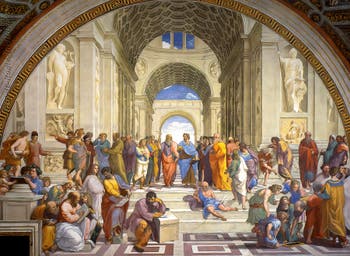
Raphael, School of Athens This room where the pope signed the bubbles and encyclicals was called the “Signature Chamber” around the middle of the sixteenth century.
Pope Julius II decided to transform it into a personal library to store his most precious books.
He wanted the decoration to be done to glorify the wisdom of the Catholic Church.
This took place when the Church sought new legitimacy based on the best pagan science had produced while reducing it to a premonition of Christian doctrine.
The signature chamber was, therefore, to serve to celebrate the various disciplines of knowledge, fields conceived as paths to reach the Truth of Christian revelation.
The aim was to praise philosophy, the sciences and the arts as the foundations of both spiritual and temporal governance, united unspeakably under the pontificate of Julius II.
It is here that the famous fresco of the School of Athens by Raphael is located.
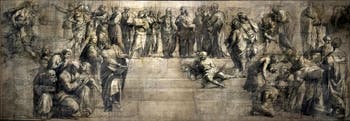
Raphael, School of Athens A fresco dedicated to knowledge and philosophy dominated by two central characters, Plato and Aristotle, surrounded by the thinkers of classical Antiquity.
52 characters are represented here by Raphael.
The scene is presented in successive levels.
In the foreground, the various forms of knowledge correspond to the liberal arts as they were understood in the Middle Ages.
In the background, Plato and Aristotle represent the two major rival schools of thought surrounded by the main philosophical trends.
On the left are the oldest schools with Pythagoras, then Socrates and his followers, while on the right are the Stoics, the Cynics, the Epicureans and other schools, and the ancient masters of the exact sciences, such as Euclid.
The Basilica of the School of Athens

Raphael, School of Athens Around fifty philosophers and mathematicians of Antiquity are represented in a majestic and luminous building corresponding to an architectural space in symbiosis with the architect Bramante’s project for Saint Peter’s Basilica, which was still under construction at the time of the creation of Raphael’s fresco.
This “open” architecture allows a glimpse of the sky; it is bathed in a golden light that envelops the scene in such a way as to transmit to the viewer a feeling of solar peace where the movement of thought is expressed before his eyes.
This ancient basilica is an intangible building, without foundations or roof, without gravity, which seems suspended in the air.
An exceptional visual creation that was completely new at the time.
Some critics believe that highlighting Bramante as Euclide in the fresco would mean that Bramante would have helped Raphael to create this part of the scene.
But according to others, Raphael did not need any help, and the place he gave Bramante here was simply due to the friendship that linked them.
Friendship and mutual trust, since it was thanks to Bramante’s relations with the Vatican that Raphael was able to obtain most of his orders.
The Ladder of Knowledge at the School of Athens
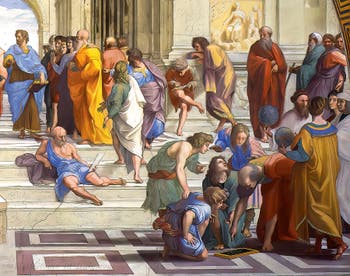
Raphael, School of Athens The main central staircase where all these scholars appear is not a simple architectural element used to “place” figures on stands.
It also represents the “degrees” of philosophical and scientific training to progress in knowing the Truth.
Starting the history of philosophy with the lower group on the left and continuing it with the group located on the same level on the right, Raphael thus laid the foundations of speculative philosophy, mathematics, geometry, and the other sciences.
Philosophers of the Athens School
Raphael’s strength lies in knowing how to give life to the philosophers of the Athens School by showing the path of their reflection and the expression of their words.Abstract thoughts, indeed, but belonging to lively, passionate men with strong character.
The Athens School represents a stage in the process of perfecting the soul.
In this symbolic journey, virtue plays a mediating role in accessing the divine world, the planetary world governed by the mathematical principles that generate the harmony of the celestial spheres: “Virtutibus itur ad astra”.
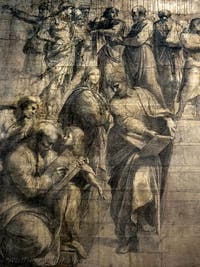
Raphael School of Athens To create this work, which was supposed to represent the multiple aspects of Julius II’s papal court combined with the thought of the ancient world, Raphael had the superb idea of staging the discussion between philosophers and wise men from all over Antiquity.
To do this, he had to give them attributes that would allow them to be recognized and locate them in space to show and highlight the different sides of the Truth, thus illustrating the path to follow and the steps to be taken to reach universal Truth.
Finally, let us not forget that this work, intended to decorate the papal library, was also meant to satisfy Pope Julius II by flattering him and highlighting him personally.
By lending to all of these wise men the faces of contemporaries who were part of the papal court, Raphael showed the viewer that the court of Julius II was simply a modern reincarnation of ancient science.
Plato and Aristotle at the centre of the School of Athens
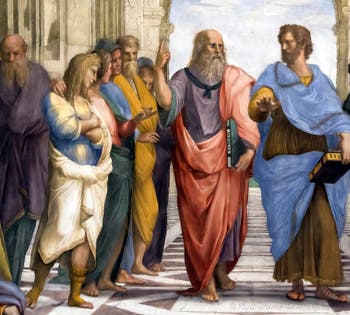
Raphael, School of Athens Plato and Aristotle, the two pillars of Philosophy, stand at the centre of the scene and perspective.
They stand beside each other, concentrating, with their lips closed, and their eyes meet and confront each other with great intensity.
On the one hand, Plato, the idealist, shows the sky.
On the other hand, Aristotle, the realist, relies on experience.
Their importance, due to their positioning in the central axis of the work, is reinforced by the colour of their pale red and sky blue coats, which, put side by side, help attract the viewer’s eye.
Plato, the wise, the contemplative, the elderly and with a long beard, is dressed in an antique style in a pale red mantle.
He points calmly with his index finger to the sky, thus indicating the divine world of Ideas, the only reality, according to him, the central element in his thinking.
With his other hand, he holds a closed book, the “Timaeus”, which deals with the genesis of the Universe, its birth and its constitution according to the laws of cosmic harmony identical to those that regulate musical harmony.
A musical harmony through which it is possible to rise to gain wisdom.
As Plato indicates in the “Republic”:
“The seven strings of Apollo’s lyre reproduce the harmony of the planetary spheres.”
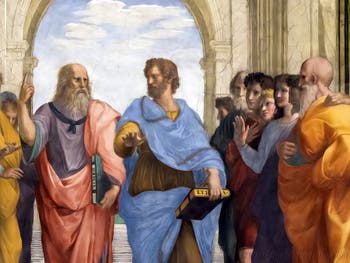
Raphael, School of Athens The “Timaeus” was Plato’s text most appreciated by the intellectuals who were part of the court of Pope Julius II.
This text by Plato deals with the role of the Demiurge, the architect God of the Universe, with the Nature of the four elements and the triangle defined as the primary geometric figure.
All these principles are an integral part of Christian thought.
To Plato’s right, in contrast, stands Aristotle wearing a sky-blue cloak.
He appears young, active, and dynamic. He represents the other major system of classical thought.
For him, the Universal has no existence of its own because it is realized and incarnated in the Particular.
To support his position, Aristotle extends the palm of his open hand to the earth, the reality of the experience, in opposition to Plato’s gesture pointed to the sky.
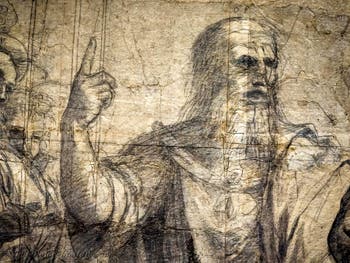
Raphael, School of Athens Aristotle owes his famous “Nicomachean Ethics”, according to which practical virtue is justice.
Two books, the “Timaeus” and the “Nicomachean Ethics”, greatly influenced Christian thinkers, two works whose subjects correspond to their authors: the theory of Plato, the idealist, and the practice of Aristotle, the realist.
But Raphael’s choice for the “Nicomachean Ethics“ is not only linked to the symbolic book that should represent Aristotle, but this work is also an open criticism of Platonic theories where they are contested almost disdainfully.
Raphaël created an obvious opposition between the two philosophers through their gestures, looks, and respective books.
Theology, Philosophy, Three men, one face?
We know that Raphael took the features of many of his contemporaries to paint the Athens School.Still, while no one has succeeded in identifying which one was supposed to represent Aristotle, almost all critics agree that Plato’s features are those of Leonardo da Vinci.
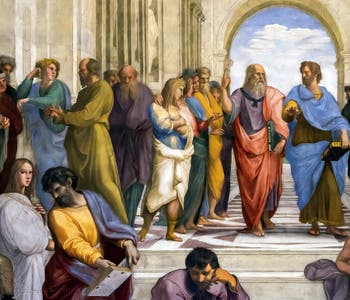
Raphael, School of Athens This hypothesis, however, was rejected by the art critic Daniel Arasse in his book “Story of Painters”.
According to him, it is unlikely that it was Leonardo da Vinci since Raphael had not seen him for at least ten years when he painted this work.
In addition, according to Arasse, to designate Plato, Raphael would have used a well-known drawing that represented “The Philosopher”, namely... Aristotle!
This would therefore explain the impossibility of putting a name on Aristotle’s face since Raphael would thus have voluntarily given “Aristotle’s features” to Plato, who thus becomes “The Philosopher”.
Philosophy and theology are brought together here by Raphael in the sense that they represent the two methods for discovering the Truth.
Theology seeks the Supernatural, revealed by the Holy Scriptures, where faith and reason walk together, while philosophy seeks the Real using logic alone.
By following this hypothesis, Raphael would have had the genius of representing two sides of the same coin between Plato and Aristotle, giving even more depth to this work.
In our opinion, a third reading is still possible because of the subtleties of which Raphael was capable.
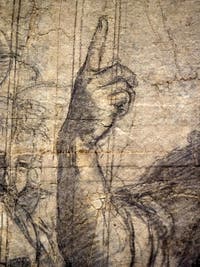
Raphael School of Athens The raised index finger is a particular signature in Leonardo da Vinci’s paintings.
Even if he indicates the world of divine ideas here, he can just as easily refer to da Vinci’s “brand”.
Although Raphael had not seen Da Vinci for ten years, since the time when Da Vinci, born in 1452, was already over fifty, his facial features were already well marked and close to his features at the age of 60.
This reduces the value of Arasse’s objection so that we can say it would indeed be Leonardo da Vinci.
We think Raphael wanted to play on all three levels at once: a double-sided medal by playing to draw the features classically attributed to the “philosopher Aristotle” on Plato’s face while giving him the look and mark of Leonardo da Vinci.
A position that can easily be justified on the part of Raphael.
In fact, it would not only be a question of paying tribute to one of his teachers but, more subtly, of introducing the “da Vinci” questioning within the major philosophical and religious theories represented in the School of Athens.
If Leonardo da Vinci is celebrated today, that was not the case in his time.
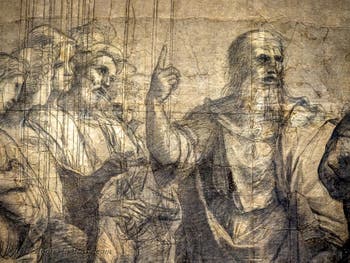
Raphael, School of Athens Indeed, da Vinci was one of the most controversial artists because his ideas were considered extravagant and incomprehensible to his contemporaries.
He was an artist who, all his life, sought the Truth relentlessly while trying to discover and understand the laws of Nature.
Leonardo da Vinci was ahead of his time, which perplexed those unable to understand him, or turned into enemies, those whose theories could be challenged by his works and discoveries.
This would therefore be a particularly subtle way for Raphael to introduce Leonardo da Vinci, his modernity and his avant-garde ideas in this apology for classical thought represented by the School of Athens.
Raphael escaped all criticism since the features of his Plato Leonardo were at the same time those commonly used to represent “the Philosopher.”
Diogenes
Diogenes is lying down, one could even say sprawled, half-clothed, in the centre of the stairs, at the feet of Aristotle.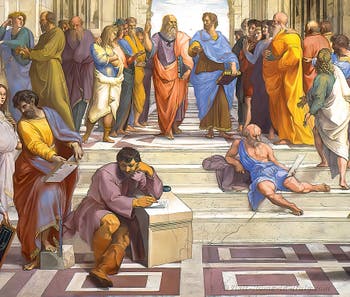
Raphael, School of Athens Diogenes the Cynic represents the rejection of social conventions and the return to Nature.
Like Heraclitus at the bottom of the stairs, Diogenes is entirely absent from the scene, as if he distance himself from the others.
Absorbed by reading the text on the sheet he is holding in his left hand, he is absolutely not concerned with what is happening around him.
Diogenes had decided to have nothing but the essentials. Hence the simple wooden bowl beside him symbolizes his way of life.
Plato called him “the angry Socrates” because his irony and critical sense were nothing but sarcasm and pure provocation.

Raphael, School of Athens It is said that Alexander the Great met him while he was lying on the ground in a square and asked him to make a wish so that he could please him, to which Diogenes simply replied: “Get off my sun.”
It is also said that one day Diogenes saw a child drinking water in the palm of his hand, and, seeing this, he threw away his wooden bowl and said that the boy had taught him a lesson in humility.
An attitude totally contrary to the wealth displayed by the Vatican and the Church at that time!
Probably another subtle message from Raphael to the official spectators at the court of Julius II, who lived in scandalous opulence in the face of the poverty that was rife at the same time in Rome, leading to the revolt, and to Martin Luther’s Reformation less than ten years later.
Page 2: Right and Left part of the School of Athens
Art Story Sistine Chapel | Raphael | Caravaggio | da Vinci | Giotto | Titian | Veronese | Sculptures | Van Gogh |
Vatican Art Story | Location | Opening Hours Tickets | Authorisations
Back to Top of Page

